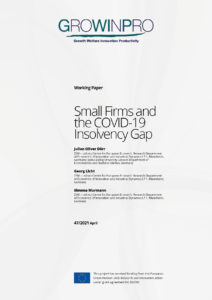COVID-19 placed a special role on fiscal policy in rescuing companies short of liquidity from insolvency. In the first months of the crisis, SMEs as the backbone of Germany’s economy benefited from large and mainly indiscriminate aid measures. Avoiding business failures in a whatever- it-takes fashion contrasts, however, with the cleansing mechanism of economic crises: a mechanism which forces unviable firms out of the market, thereby reallocating resources efficiently. By focusing on firms’ pre-crisis financial standing, we estimate the extent to which the policy response induced an insolvency gap and analyze whether the gap is characterized by firms which were already struggling before the pandemic. With the policy measures being focused on smaller firms, we also examine whether this insolvency gap differs with respect to firm size. Our results show that the COVID-19 policy response in Germany has triggered a backlog of in- solvencies that is particularly pronounced among financially weak, small firms, having potential long term implications on entrepreneurship and economic recovery.

 Small Firms and the COVID-19 Insolvency Gap
Small Firms and the COVID-19 Insolvency Gap